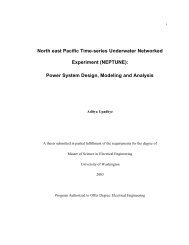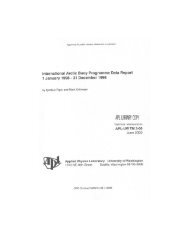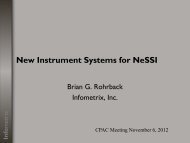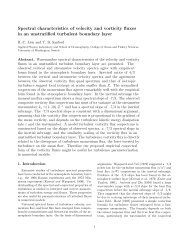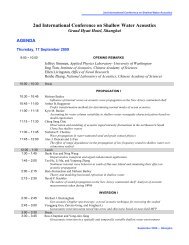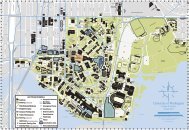2009 Biennial (PDF, 12 MB) - Applied Physics Laboratory-University ...
2009 Biennial (PDF, 12 MB) - Applied Physics Laboratory-University ...
2009 Biennial (PDF, 12 MB) - Applied Physics Laboratory-University ...
Create successful ePaper yourself
Turn your PDF publications into a flip-book with our unique Google optimized e-Paper software.
ReseARCh highLights ReseARCh highLights<br />
Chromophores and Nanowires<br />
Chromophores are parts of molecules that absorb, transmit, or reflect certain<br />
wavelengths of visible light to give color. Polymers engineered with chromophores<br />
are sensitive to the physical and chemical environment to which they are exposed.<br />
Experiments in the APL-UW photonics lab show that some of these polymers have a<br />
strong interaction with molecules that comprise high-explosive compounds.<br />
The polymer films are manufactured to one micrometer thick and their color change,<br />
from dark blue to light purple in the presence of trace explosive vapors, is visible to the<br />
unaided eye. Accompanying this change in the absorption spectrum is a change in<br />
the refractive index—the speed of light waves passing through the medium —which<br />
can be measured much more accurately. The sensing films are further enhanced with<br />
micro-ring resonating structures and Bragg gratings tuned to certain wavelengths,<br />
which amplify the effect of the sensor material on the optical wave. Tests show that<br />
such sensors have part-per-billion sensitivity to simulated explosive vapors in air.<br />
Another discovery was reported recently by APL-UW scientists and students: thin<br />
films of random nanowires of certain metal oxides change their electric resistance<br />
significantly and rapidly upon exposure to explosive vapors. Nanowires are structures<br />
with a diameter on the order of nanometers and length-to-width ratios greater<br />
than 1000. Their extremely large surface-to-volume ratio renders them nearly onedimensional<br />
materials, yielding interesting quantum mechanical properties. A test<br />
sensor of titanium oxide film has gone through millions of cycles between explosive<br />
vapor and fresh air without noticeable degradation. It is possible that a low-power<br />
microsensor could be integrated on silicon chips to enable unattended perpetual<br />
surveillance against explosive devices.<br />
Terahertz Spectroscopy<br />
Terahertz (THz) radiation—electromagnetic waves at frequencies of trillions of cycles<br />
per second (between radio waves and infrared light)—penetrates common obscuring<br />
materials such as cloth, wood, or paper, and “sees” targets hidden behind them.<br />
Explosives have characteristic spectral features (fingerprints) at THz frequencies. Wellcontrolled<br />
laboratory experiments using carefully prepared test samples have shown<br />
that THz spectroscopy can identify concealed explosives, but significant challenges<br />
exist for real-world applications. Most THz spectroscopic measurements have been<br />
conducted in transmission mode. Unfortunately, measurements of transmission<br />
spectra are unlikely in practice because they require a non-opaque target (i.e., small<br />
sample thickness) and placement of the sample between the THz source and detector.<br />
These requirements compromise the feasibility of standoff detection.<br />
APL-UW researchers, in a joint effort with Dr. Lisa Zurk of Portland State <strong>University</strong>,<br />
are seeking to develop and validate a model for backscattering of THz waves from<br />
targets. With the THz source and detector co-located and “looking” at the target from<br />
a distance, a reflection geometry of the THz response can be processed to produce<br />
spectral signatures. Most target surfaces, however, are rough at THz frequencies, so<br />
simple reflections from targets cannot be expected. Instead, the THz waves returning<br />
after interacting with a target spread over a wide range of angles.<br />
Researchers are exploring the idea that the rough surface scattering of THz waves can<br />
be exploited to produce a more robust method of spectroscopic detection. When<br />
rough surface scattering from a target applies, no special target orientation would be<br />
required to see the returning THz waves, that is, we need not hope to catch a “glint”<br />
from the target, but instead attempt to detect the diffuse scattering return. The goal of<br />
the ongoing research is to understand if the spectral signatures of explosive chemicals<br />
can be detected reliably in the diffuse backscattered THz waves from rough targets.<br />
A Superresolution Algorithm<br />
Another project is directed toward enhancing the capabilities of radar systems to<br />
detect and locate IEDs. Because explosive devices are often located in very complex<br />
environments, radar sweeps encounter a great deal of clutter, which often gives a<br />
stronger radar signal than the target itself. Some of the clutter is used to conceal the<br />
devices, such as boxes, cars, vegetation, or soil. This means that longer-wavelength<br />
radar must be used to penetrate the concealment, but the longer wavelengths limit<br />
the resolution, and poorer resolution makes it harder to distinguish an explosive device<br />
from the clutter.<br />
APL-UW researchers are developing a fast data-fitting algorithm, originally used in<br />
sonar applications, to improve the resolution of any radar system. It uses a simple,<br />
computationally efficient model to fit the data, beginning with the strongest signal<br />
first, rather than fitting the entire scene. These brightest signals are subtracted from<br />
the data and successively weaker ones are fit through iteration, thus increasing the<br />
ability to discern a signature of interest. More capable radar systems will improve the<br />
detection and location of targets from a moving vehicle before approaching to within<br />
a dangerous range of the explosives.<br />
Machine Learning<br />
The Navy’s program includes predicting and preventing the emplacement in the first<br />
place. The key to successful prediction is the ability to learn complex patterns from<br />
heterogeneous data sources, such as surveillance reports, cell phone traffic, and the<br />
social network structure of the local population. These types of data are naturally<br />
described by pairwise relationships between entities, and pose challenges to traditional<br />
machine learning techniques.<br />
Troops in the field can often discern these complex patterns and make good predictions<br />
based on some cognitive measure of similarity between a potential threat and past<br />
IED events. Can computers be taught to learn effectively from similarities? APL-UW<br />
is advancing the state-of-the-art in machine learning by developing algorithms that<br />
natively learn based on the pairwise similarity of heterogeneous data. The end goal is<br />
to assist the deployed troops with tools that increase their decision throughput and<br />
accuracy.<br />
This effort is an example of how the Navy has tapped the complete resource available<br />
at a university-affiliated research center. The APL-UW machine learning research<br />
is a close collaboration with the Information Design <strong>Laboratory</strong> in the <strong>University</strong> of<br />
Washington’s Department of Electrical Engineering. The collaboration has advanced<br />
the field of machine learning in the scientific literature and has provided funding to<br />
train students in Navy-relevant problems. Luca Cazzanti, who now heads the APL-UW<br />
side of the collaboration, completed his Ph.D. under the project and now helps guide<br />
the research of current graduate students.<br />
Team members: M. Hassan Arbab, William Asher, Luca Cazzanti, Antao Chen, Wm.<br />
Timothy Elam, Frank Henyey, Jeffrey Simmen, Eric Thorsos, Danling Wang, and Dale<br />
Winebrenner<br />
Sponsor: ONR<br />
18 APL–UW <strong>2009</strong> BienniAL RePoRt APL–UW <strong>2009</strong> BienniAL RePoRt 19



